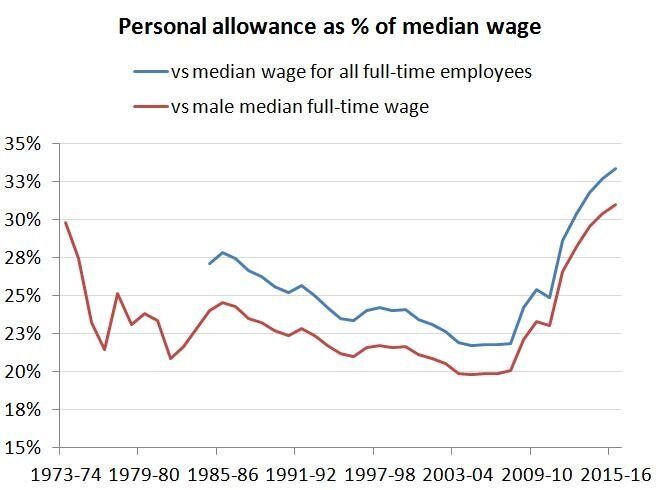Next Wednesday George Osborne looks set to announce a further increase in the personal allowance. With the PA already set to hit £8,105 in April, a further rise to around £8,800 in 2013 would keep the government on track for its £10k target by election day.
Debate about the policy's merits has already begun, with the IFS pointing out last week that it's a poorly targeted way of helping low to middle income households. But stepping back from these short-term arguments over distributional effects, how ambitious a legacy would the £10k income tax allowance be for the Coalition?
Looked at one way, the policy is much less radical than the headline figures imply. Even without the Lib Dems, as the IFS pointed out this week, the personal allowance would rise to £8,885 by 2015 on the back of inflation; in other words, more than 40% of the remaining increase to £10k would happen anyway. So the DPM is walking up the up escalator and getting more credit for the legwork - and, from some quarters, more flack - than he deserves.
Stepping back, though, the allowance pledge looks bolder. For close on 30 years the allowance has been declining in value relative to median earnings, dragging more and more people into tax. As Figure one shows, achieving the £10k pledge will mean a stark reversal of this trend and one that by no means would have happened naturally. Allowing tax thresholds to drift downwards relative to wages--known as 'fiscal drag'--has long been a ruse of Chancellors eager for an easy flow of cash. (In fact, as the chart reminds us, it was an approach particularly beloved of Nigel Lawson, who switched from an early policy of raising the allowance to one of allowing it to fall while majoring on cuts to the basic rate.) The Lib Dem's new approach ends this long running ploy and makes it harder for Chancellors to use in future.

This brings us onto the politics and the biggest long-term implication of next week's allowance announcement. Once the dust settles post-Budget, a clearer path to £10k should open up new space for a debate about how our tax-benefit system supports low to middle income households.
This is, in part, because the Lib Dems strategy questions some long-running assumptions about what works politically as a 'low tax for low earners' policy. First, Labour and the Tories have for a long time looked no further than reducing the marginal tax rate (the 20% or 40% figure) as their headline tax cutting measure. Indeed, Labour's main attempt at a tax policy for low earners--creating (and then later infamously scrapping) a 10p tax rate--was based in part on this judgment that it's only the marginal rate that matters. Both main parties will be surprised by the traction the Lib Dems have achieved on the allowance.
Second, it is startling that the Lib Dem allowance policy, despite being unarguably regressive, is still quite so broadly accepted as being targeted at low to middle income households. True, it performs a little better as a way of supporting for low earning individuals. But it is still a grossly inefficient way of supporting even this group. The perception of the allowance policy has proven remarkably robust to this fact.
In a pre-Budget week this all means little more than some tactical difficulties for Labour. In this period, Ed Balls must surely be right to prioritise a straightforward attack on forthcoming cuts to tax credits rather than critiquing the design of the allowance move. As Resolution Foundation analysis showed this weekend, £2.4bn of new cuts to tax credits are set to bite from April this year, in part to fund the higher personal allowance. These cuts are laser targeted at precisely the low to middle income households the DPM claims to support. In fact, 70% of April's tax credit cuts fall on the bottom half of households while, at precisely the same time, 75% of the benefits of the £630 allowance increase will go to the top half, including households earning up to £200k. This is surely upside down.
Longer term, though, the real policy challenge for both Labour and the Lib Dems will be to find a more nuanced position on the respective roles of tax credits and the personal allowance. That's a debate we kicked off yesterday at the Resolution Foundation with a head to head between the two approaches. Despite strong arguments from supporters of each side, the most interesting lesson was the potential for a strategy balanced between the two.
For those concerned about low to middle income households this must surely mean, at the very least, a robust rejection of any approach that cuts tax credits to fund increases in the allowance. It probably also requires limiting the gains of a higher allowance to basic rate taxpayers. But it will also mean acknowledging that Labour's strategy, which let the allowance fall in relative terms--and thereby meant, however implicitly, a higher tax take from low earners being used to fund tax credits--also has its shortcomings. For the next few weeks the short-term impacts of any allowance move will rightly dominate debate. Sooner or later, though, these bigger reform questions will need to be addressed.
